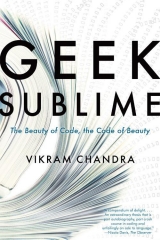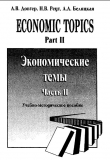
Текст книги "Geek Sublime: The Beauty of Code, the Code of Beauty"
Автор книги: Vikram Chandra
Жанры:
Современная проза
,сообщить о нарушении
Текущая страница: 13 (всего у книги 15 страниц)
NOTES
Chapter 1: Hello, World!
1. Graham, “Hackers and Painters.”
2. Ibid.
3. Ibid.
4. Lampson, “Guest Editorial,” 195.
5. Ibid., 196.
6. Wright and Daintith, A Dictionary of Computing, 205.
7. Knuth, “Literate Programming,” 99.
8. Ibid.
9. Mataes and Montford, “A Box, Darkly,” 145.
10. Ibid., 194.
11. “The IBM 650 Magnetic Drum Calculator”; Mataes and Montford, “A Box, Darkly,” 194.
12. Oram and Wilson, Beautiful Code, loc. 482.
13. Ibid., loc. 473.
14. Mataes and Montford, “A Box, Darkly,” 145.
15. Ceglowski, “Dabblers and Blowhards.”
16. Graham, “Design and Research.”
17. Graham, “Hackers and Painters.”
18. Ceglowski, “Dabblers and Blowhards.”
19. Ibid.
Chapter 2: Learning to Write
1. Simon, Spies and Holy Wars, 98.
2. Jcoll [pseud.], “For Most of You, This Is Surely Child Play, but Holy Shit, This Must Be What It Feels Like to Do Heroin for the First Time.”
Chapter 3: The Language of Logic
1. Rob P., “How Do Computers Work?”
2. Jong89 [pseud.], “Razorlength—1036 Early Winter by Jong89.”
3. “Computer Scientists Build Computer Using Swarms of Crabs.”
4. Petzold, Code, 101–02.
5. See Gleick, The Information, loc. 2056–69.
6. Rob P., “How Do Computers Work?”
7. Ganssle, “Microprocessors Change the World.”
8. Winegrad and Akera, “A Short History of the Second American Revolution.”
9. Ganssle, “Microprocessors Change the World.”
Chapter 4: Histories and Mythologies
1. Rosenberg, Dreaming in Code, 300–01.
2. Nather, “The Story of Mel.”
3. Ibid.
4. Ibid.
5. Ibid.
6. Used with permission from Microsoft. Lippert, “Cargo Cultists, Part Three: Is Mort a Cargo Cultist?”
7. Ibid.
8. Ibid.
9. Ibid.
10. Ibid.
11. Nather, “The Story of Mel.”
12. Ibid.
13. Wozniak, “And Then There Was Apple.”
14. Livingston, Founders at Work, 45.
15. Ibid., 49.
16. DFectuoso [pseud.], “Solo Development – Are There Any Famous One-Man-Army Programmers?”
17. “Programming the ENIAC.”
18. Ensmenger, The Computer Boys Take Over, 14–15.
19. Ibid., 37.
20. Ibid., 39.
21. Ibid., 74.
22. Ibid., 238.
23. Ibid., 16.
24. Ibid., 69.
25. Ibid., 79.
26. Ibid., 137.
27. Ibid., 144.
28. Ibid., 231.
29. Ibid., 168.
30. Ibid., 239–40.
31. Griffin, “The Place of the Bengali in Politics,” 812.
32. Ibid., 813.
33. Barrett, “Why We Don’t Hire.NET Programmers.”
34. Ibid.
35. Ibid.
36. Solnit, “Diary.”
37. Ibid.
38. See Lacy, “And You Thought SF Cabs Were Bad? BART Strike Is Crippling Fledgling Mid-Market Tech Corridor.”
39. Silver, “In Silicon Valley, Technology Talent Gap Threatens G.O.P. Campaigns.”
40. Barbrook and Cameron, “The Californian Ideology,” 44.
41. Ibid., 55.
42. Matyszczyk, “Woz: Microsoft Might Be More Creative Than Apple.”
43. Torvalds, “Re: Stable Linux 2.6.25.10”; Leonard, “Let My Software Go!”; Raymond, “Microsoft Tries to Recruit Me.”
44. Bailey, “Dear Open Source Project Leader: Quit Being a Jerk.”
45. Alec Scott, e-mail to author, November 29, 2012.
46. Brockmeier, “How Casual Sexism Put Sqoot in the Hotseat.”
47. Bassett, “Aligning India in the Cold War Era,” 786.
48. Bassett, “MIT-Trained Swadeshis,” 215.
49. Ibid., 213.
50. Ibid., 215.
51. Ibid., 225.
52. Ibid., 227.
53. Ibid.
54. Ibid., 229–30.
55. Bassett, “Aligning India in the Cold War Era,” 783.
56. Ibid., 791.
57. “Immigrant Entrepreneurship Has Stalled for the First Time in Decades, Kauffman Foundation Study Shows.”
58. Khan, “40 % of Startups in Silicon Valley Are Headed by India-Based Entrepreneurs.”
59. Stahl, “Imported from India.”
60. Sivakumar, Dude, Did I Steal Your Job?, 33.
61. Mukherji, “Student Suicides Soar 26 % in 5 Years, Education System Blamed.”
62. Spectre, “Twilio’s Definitive Brogramming Primer.”
63. MacMillan, “The Rise of the ‘Brogrammer.’”
64. Scott, “Lessons from Canada’s Silicon Valley Diaspora.”
65. World Economic Forum, Global Gender Gap Report.
66. “We believe that currently in most IT companies (IBM India, Accenture India, Infosys, Wipro, TCS, HCL, Cognizant, iGate, etc.), the percentage of women is also 30 % at the lower level …” Alok Aggarwal (co-founder and chairman, Evalueserve), e-mail to author, December 8, 2012; “Household Data Annual Averages: Employed Persons by Detailed Occupation, Sex, Race, and Hispanic or Latino Ethnicity.”
67. Varma, “Exposure, Training, and Environment,” 205; DuBow, “NCWIT Scorecard: A Report on the Status of Women in Information Technology.”
68. Varma, “Computing Self-Efficacy among Women in India,” 257.
69. Varma, “Exposure, Training, and Environment,” 213.
70. Ibid., 215.
71. Ibid., 217.
72. Ibid., 219.
73. Ibid.
74. Alok Aggarwal (co-founder and chairman, Evalueserve), e-mail to author, December 8, 2012.
75. Alok Aggarwal (co-founder and chairman, Evalueserve), e-mail to author, February 15, 2013.
76. Varma, “Exposure, Training, and Environment,” 219.
77. Fine, Delusions of Gender, 94.
78. Ibid., 181–82.
79. Sivakumar, Dude, Did I Steal Your Job?, 34.
80. Ibid., 140–46.
81. Ibid., 144.
82. Ibid., 141.
83. Wadhwa, “The Face of Success, Part I: How the Indians Conquered Silicon Valley.”
84. See, for instance: Raj, “Indian Mafia”; Warner, “The Indians of Silicon Valley.”
85. Lanier, “The Suburb That Changed the World.”
Chapter 5: The Code of Beauty: Anandavardhana
1. Ramanujan, The Interior Landscape, 74.
2. Ibid., 115.
3. Harpham, “Aesthetics and the Fundamentals of Modernity,” 124–25.
4. See Leeming, The Oxford Companion to World Mythology.
5. Kiparsky, “Paninian Linguistics,” 1.
6. “Astadhyayi has two distinct bodies of sutras – the 14 Maheswara or pratyahara sutras of Sanskrit varnas, sounds, that are the primary building blocks of the Sanskrit language, that are enumerated before the sutrapatha begins. The sutrapatha, according to the now ascertained authentic text (ed. by Pt. Narayana Mishra and published by Chowkhamba Varanasi) has 3976 sutras. Sometimes the 14 pratyahara sutras are conjoined to make the total 3990.” Kapil Kapoor, e-mail to author, September 9, 2013.
7. Kiparsky, “Paninian Linguistics,” 5.
8. See Matthews, The Concise Oxford Dictionary of Linguistics, 284.
9. Kiparsky, “Paninian Linguistics,” 6.
10. Ibid., 7.
11. Panini, Ashtadhyayi, 47.
12. Kapoor, Text and Interpretation: The Indian Tradition, 74.
13. Joshi, “Background of the Aṣṭādhyāyī,” 2.
14. Ganeri and Miri, “Sanskrit Philosophical Commentary,” 193.
15. See Manjali, “The ‘Social’ and the ‘Cognitive’ in Language: A Reading of Saussure, and Beyond.”
16. Emeneau, “Bloomfield and Pānini,” 759.
17. Ibid., 758–59.
18. Bloomfield, Linguistic Aspects of Science, 2.
19. Kiparsky, “Paninian Linguistics.”
20. Kiparsky, “On the Architecture of Pāṇini’s Grammar.”
21. Emeneau, “India and Linguistics,” 150.
22. Ingerman, “Panini-Backus Form Suggested,” 37.
23. Kelly, “What Was Sanskrit For? Metadiscursive Strategies in Ancient India,” 103–04.
24. Pollock, The Language of the Gods in the World of Men, 50.
25. Houben, “Sociolinguistic Attitudes Reflected in the Work of Bhartṛhari and Some Later Grammarians,” 169.
26. Muller-Ortega, The Triadic Heart of Śiva, 133.
27. Pollock, The Language of the Gods in the World of Men, 53.
28. Ibid., 54.
29. Ibid., 55–56.
30. Briggs, “Knowledge Representation in Sanskrit and Artificial Intelligence,” 34.
31. Ibid., 36.
32. Ibid., 35–36.
33. Ibid., 39.
34. See Bhate and Kak, “Panini’s Grammar and Computer Science”; Staal, “Context-Sensitive Rules in Pāṇini”; Subbanna and Varakhedi, “Computational Structure of the Aṣṭādhyāyīand Conflict Resolution Techniques”; Saxena, Parul Saxena, and Pandey, “Panini’s Grammar in Computer Science.”
35. See “Similarities between Sanskrit and Programming Languages”; “Why Sanskrit Is Best Language for Computer?”
36. Jha and Mammaṭācārya, The Kāvyapṛakāsha of Mammaṭa, 148–49.
37. Ingalls Sr, Masson, and Patwardhan, TheDhvanyaloka of Anandavardhana with theLocana of Abhinavagupta, 131.
38. Ibid., 130.
39. Ibid., 122.
40. Ibid., 113.
41. Translated from Anandavardhana’s Dhvanyaloka(1.4 b) by Luther Obrock.
42. Translated from Anandavardhana’s Dhvanyaloka(1.4 c) by Luther Obrock.
43. Translated from Anandavardhana’s Dhvanyaloka(2.27 a) by Luther Obrock.
44. Bharata Muni and Rangacharya, The Nāṭyaśāstra, 55.
45. Translated from Anandavardhana’s Dhvanyaloka(2.22 b) by Luther Obrock.
46. Ingalls Sr., Masson, and Patwardhan, TheDhvanyaloka of Anandavardhana with theLocana of Abhinavagupta, 312.
47. Translated from Anandavardhana’s Dhvanyaloka(2.1 a) by Luther Obrock.
48. Ingalls Sr., Masson, and Patwardhan, TheDhvanyaloka of Anandavardhana with theLocana of Abhinavagupta, 204.
49. Ibid., 206.
50. Ibid., 105.
51. Hogan, “Towards a Cognitive Science of Poetics: Anandavardhana, Abhinavagupta, and the Theory of Literature,” 164.
52. Ingalls Sr., Masson, and Patwardhan, TheDhvanyaloka of Anandavardhana with theLocana of Abhinavagupta, 546.
53. Ibid., 679.
54. Ibid., 714–15.
55. Ibid., 636.
56. Ibid.
57. Ibid., 641–42.
58. O’Connor, Mystery and Manners, 96.
Chapter 6: The Beauty of Code
1. Matsumoto, “Treating Code as an Essay,” 478.
2. Ibid., 481.
3. Ibid., 477.
4. Purushothaman and Perry, “Toward Understanding the Rhetoric of Small Source Code Changes,” 513; McPherson, Proffitt, and Hale-Evans, “Estimating the Total Development Cost of a Linux Distribution.”
5. Knuth, “All Questions Answered,” 320.
6. Foote and Yoder, “Big Ball of Mud,” 653.
7. Paltrow and Carr, “How the Pentagon’s Payroll Quagmire Traps America’s Soldiers.”
8. Ensmenger, The Computer Boys Take Over, 227.
9. “The International Obfuscated C Code Contest.”
10. Ibid.
11. Scheffer, “Programming in Malbolge.”
12. Hayes, “Computing Science: The Semicolon Wars,” 299.
13. Dijkstra, “How Do We Tell Truths That Might Hurt?” 14.
14. “How SQLite Is Tested.”
15. “Most Widely Deployed SQL Database Engine.”
16. Savoia, “Beautiful Tests,” loc. 3010.
17. Bloch, “Extra, Extra – Read All About It: Nearly All Binary Searches and Mergesorts Are Broken.”
18. Grimes, “In His Own Words.”
19. Yegge, “Foreword,” XVII–XVIII.
20. “Hype Cycle Research Methodology.”
21. “GitFaq – Git SCM Wiki.”
22. Wolfcore [pseud.], comment on “Git Is Simpler Than You Think.”
23. “Whatever Happened to Programming?”
24. Campbell, “Where Does One Go to Find the Current ‘Good’ Books to Read? (Or Blogs?)”
25. Ensmenger, The Computer Boys Take Over, 88.
26. Kwak, “The Importance of Excel.”
27. Ibid.
28. Ibid.; Schlesinger, “JPMorgan Chase Earnings: ‘London Whale’ Cost $5.8 Billion.”
29. Oliver, “Why I Still Love CQRS (and Messaging and Event Sourcing).”
30. Ibid.
31. Zihotki, “Raven & Event sourcing.”
32. Chakrabarti, “Arguing from Synthesis to the Self: Utpaldeva and Abhinavagupta Respond to Buddhist No-Selfism,” 203.
33. Ibid., 209.
34. Ibid., 211.
Chapter 7: The Code of Beauty: Abhinavagupta
1. Gnoli and Abhinavagupta, The Aesthetic Experience According to Abhinavagupta, 55.
2. Ibid., 54–55.
3. Ibid., 64.
4. Ibid., 64–65.
5. Ibid., 66.
6. Ibid., 113.
7. Ibid., 61.
8. Ibid., 81.
9. Ibid., XXXVI.
10. Ibid., 117.
11. Ingalls Sr., Masson, and Patwardhan, TheDhvanyaloka of Anandavardhana with theLocana of Abhinavagupta, 118.
12. Gnoli and Abhinavagupta, The Aesthetic Experience According to Abhinavagupta, XXXVI.
13. Ibid., 48.
14. Pandit, “Dhvani and the ‘Full World.’” 143.
15. Ibid.
16. Ibid., 148.
17. Ingalls Sr., Masson, and Patwardhan, TheDhvanyaloka of Anandavardhana with theLocana of Abhinavagupta, 70.
18. Masson and Patwardhan, Aesthetic Rapture, 10.
19. Ingalls Sr., Masson, and Patwardhan, TheDhvanyaloka of Anandavardhana with theLocana of Abhinavagupta, 192.
20. Ibid., 43.
21. Gnoli and Abhinavagupta, The Aesthetic Experience According to Abhinavagupta, 106.
22. McCrea, The Teleology of Poetics in Medieval Kashmir, 395.
23. Ibid., 395–96.
24. Ibid., 216–17.
25. Ingalls Sr., Masson, and Patwardhan, TheDhvanyaloka of Anandavardhana with theLocana of. Abhinavagupta, 671.
26. Ibid., 680–81.
27. Ibid., 681–82.
28. Gnoli and Abhinavagupta, The Aesthetic Experience According to Abhinavagupta, 59.
29. Ibid., 102.
30. Ingalls Sr., Masson, and Patwardhan, TheDhvanyaloka of Anandavardhana with theLocana of Abhinavagupta, 226.
31. Ibid., 592.
32. Ibid., 71.
33. Ibid., 193.
34. Ibid., 500, 505.
35. Ibid., 503–04.
36. Translated from Anandavardhana’s Dhvanyaloka(3.20 e) by Luther Obrock.
37. Douglas, Thinking in Circles, loc. 403.
38. Ibid., loc. 43.
39. Ibid., loc. 57.
40. Witzel, “On the Origin of the Literary Device of the Frame Story in Old Indian Literature,” 411.
41. Shulman, “The Buzz of God and the Click of Delight,” 56.
42. Ibid., 58.
43. See Kapoor, Dimensions of Pāṇini Grammar: The Indian Grammatical System, 193.
44. Ingalls Sr., Masson, and Patwardhan, TheDhvanyaloka of Anandavardhana with theLocana of Abhinavagupta, 437.
Chapter 8: Mythologies and Histories
1. Gupta, Hoens, and Goudriaan, Hindu Tantrism, 6.
2. White, “Introduction: Tantra in Practice: Mapping a Tradition,” 7.
3. Urban, The Power of Tantra, loc. 322–25.
4. Ibid., loc. 1091.
5. Ibid., loc. 1274.
6. Ibid., loc. 182–85.
7. Wezler, “Do You Speak Sanskrit? On a Class of Sanskrit Texts Composed in the Late Middle Ages,” 331.
8. Freely adapted from Feuerstein, Tantra, loc. 3682.
9. Urban, The Power of Tantra, 1219.
10. Davidson, Indian Esoteric Buddhism, 179.
11. See Sanderson, “Śaivism and the Tantric Traditions.”
12. Pomeda, The Heart of Recognition: A Translation and Study of Kṣemarāja’s Pratyabhijñāhṛdayam, 46.
13. Dehejia, The Advaita of Art, 129.
14. Ibid.
15. Ratié, “Remarks on Compassion and Altruism in the Pratyabhijñā Philosophy,” 350.
16. Ibid.
17. Muller-Ortega, The Triadic Heart of Śiva, 61–62.
18. Ratié, “Remarks on Compassion and Altruism in the Pratyabhijñā Philosophy,” 361–62.
19. Sanderson, “Śaivism and the Tantric Traditions,” 696.
20. Ratié, “Otherness in the Pratyabhijñā Philosophy,” 363–64.
21. Wallis, “The Descent of Power: Possession, Mysticism, and Initiation in the Śaiva Theology of Abhinavagupta,” 253–54.
22. Urban, The Economics of Ecstasy, loc. 1008.
23. Translated from the Bhaver Gitawith the help of Dilip Misra, Rakesh Mishra, and Monidipa Mondal.
24. Urban, The Economics of Ecstasy, loc. 1351.
25. Ibid., 863.
26. Ibid., 579.
27. Sanderson, “Purity and Power among the Brahmans of Kashmir,” 193.
28. Tharu and Lalita, Women Writing in India, 68.
29. Parashar and Rājaśekhara, Kāvyamīmāiṇsā of Rājaśekhara, 157.
30. Tharu and Lalita, Women Writing in India, xviii.
31. Ibid., xx.
32. Ibid., 6.
33. Ibid., 116.
34. Urban, The Power of Tantra, loc.254; Urban, The Economics of Ecstasy, loc.556.
35. Tharu and Lalita, Women Writing in India, 8.
36. Ibid., 2.
37. Ibid., 145
38. Ibid., 3.
39. Ibid.
40. Ibid., 5–6.
41. Ibid., 6.
42. Wujastyk, “Indian Manuscripts,” 1–2.
43. Ibid.
44. Dominik Wujastyk, e-mail to author, December 19, 2012.
45. Wujastyk, “Indian Manuscripts,” 2.
46. Dominik Wujastyk, e-mail to author, December 13, 2012.
47. Wujastyk, “Indian Manuscripts,” 3.
48. Copyright © 1998 by Andrew Schelling. Reprinted with the permission of City Lights Books. Schelling, The Cane Groves of Narmada River, 48.
49. Ibid., 149.
50. Ibid.
51. Rotter, “Gender Relations, Foreign Relations: The United States and South Asia, 1947–1964,” 523.
52. Ibid., 527.
53. Conrad, Heart of Darkness and Selections from the Congo Diary, loc. 1881, 2028, 1886.
54. Ibid., loc. 1011, 1454.
55. Gleick, The Information, 418.
56. Ibid., 436.
57. Ibid., 217.
Chapter 9: The Language of Literature
1. Translated from Anandavardhana’s Dhvanyaloka(3.41 a) by Luther Obrock.
2. Bronner and Shulman, “’A Cloud Turned Goose’: Sanskrit in the Vernacular Millennium,” 28–29.
3. Pollock, “The Death of Sanskrit,” 394.
4. Dalmia, “Sanskrit Scholars and Pandits of the Old School,” 334.
5. See Srinivas, “Amarabhāratī: Sanskrit and the Resurgence of Indian Civilization,” 41–42.
6. Kapoor and Ratnam, Literary Theory: Indian Conceptual Framework, 1.
7. Ramaswamy, “Sanskrit for the Nation,” 334–35.
8. Ibid., 373.
9. Pollock, “The Cosmopolitan Vernacular,” 29.
10. Merwin, East Window: The Asian Translations, 36.
11. Eliot, The Sacred Wood and Major Early Essays, 58.
12. Eliot, After Strange Gods, 43–44.
13. Sanderson, “Śaivism and the Tantric Traditions,” 675.
14. Christiansen, “Computers.”
15. Pipher, Writing to Change the World, 81.
16. Tedd, “Hours of Hell and Anguish,” 95.
17. Ibid., 97.
18. West, Conversations with William Styron, 9.
19. Review, The Paris Review Interviews, III, 22.
20. Ingersoll and Ingersoll, Conversations with Anthony Burgess, 73.
21. Fisher, The Writer’s Quotebook, 18.
22. Acocella, “Blocked: Why Do Writers Stop Writing?” 129.
23. Leeds, The Enduring Vision of Norman Mailer, 132.
24. Cowley, And I Worked at the Writer’s Trade, 191.
25. Tedd, “Hours of Hell and Anguish,” 99.
26. Ingalls Sr., Masson, and Patwardhan, TheDhvanyaloka of Anandavardhana with theLocana of Abhinavagupta, 120.
27. Matilal, “Vakroti and Dhvani: Controversies about the Theory of Poetry in the Indian Tradition,” 381.
28. Parashar and Rājaśekhara, Kāvyamīmāṃsā of Rājaśekhara, 149.
29. Gnoli and Abhinavagupta, The Aesthetic Experience According to Abhinavagupta, XLIX.
30. Muller-Ortega, The Triadic Heart of Śiva, 46.
Chapter 10: Application.Restart()
1. Muller-Ortega, “Seal of Sambhu,” 574.
2. “Fwd: Amar Chitra Katha Comics in Samskritam: Participate in Readership Survey – Google Groups.”
3. Singh, “New Life, Old Death for Sanskrit in Uttarakhand.”
4. Toole, Ada, the Enchantress of Numbers, loc. 2867–870.
5. Turing, “On Computable Numbers, with an Application to the Entscheidungs-problem (1936).”
6. Toole, Ada, the Enchantress of Numbers, loc. 2131–133.
7. Gleick, The Information, loc. 2048–052.
8. Cabanne, Dialogues with Marcel Duchamp, 18–19.
9. Fishwick, “Aesthetic Computing.”
10. Hessel, Goodman, and Kotler, “Hacking the President’s DNA.”
11. Kotler, “Synthetic Biology for Dummies, Investors or Both …”; Carlson, “The Pace and Proliferation of Biological Technologies.”
12. “iGEM 2012 HS Is Officially Over!”
13. “Team: Heidelberg LSL.”
14. Swain, “Glowing Trees Could Light Up City Streets,” 21.
15. Brown, “Stanford Team Turns DNA into a Hard Drive.”
16. Church and Regis, Regenesis, 7.
17. Ibid., 248–49.
18. Pollock, “What Was Bhaṭṭa Nāyaka Saying?” 154.
19. Skora, “The Pulsating Heart and Its Divine Sense Energies,” 445–46.
20. Flood, “The Purification of the Body,” 518–19.
21. Skora, “Abhinavagupta’s Erotic Mysticism: The Reconciliation of Spirit and Flesh,” 76.
22. Reprinted with the permission of P.N. Furbank. “Messages from the Unseen World,” The Turing Digital Archive, King’s College, University of Cambridge.
23. Cabanne, Dialogues with Marcel Duchamp, 98.
BIBLIOGRAPHY
Acocella, Joan. “Blocked: Why Do Writers Stop Writing?” New Yorker80, no. 16 (2004): 80–129.
Bailey, Derick. “Dear Open Source Project Leader: Quit Being a Jerk.” LosTechies.com, December 14, 2012. http://lostechies.com/derickbailey/2012/12/14/dear-open-source-project-leader-quit-being-a-jerk/.
Barbrook, Richard, and Andy Cameron. “The Californian Ideology.” Science as Culture6, no. 1 (1996): 44–72.
Barrett, David. “Why We Don’t Hire.NET Programmers.” Expensify (blog), March 25, 2011. http://blog.expensify.com/2011/03/25/ceo-friday-why-we-dont-hire-net-programmers/.
Bassett, Ross. “Aligning India in the Cold War Era: Indian Technical Elites, the Indian Institute of Technology at Kanpur, and Computing in India and the United States.” Technology and Culture50, no. 4 (2009): 783–810.
_______. “MIT-Trained Swadeshis: MIT and Indian Nationalism, 1880–1947.” Osiris24, no. 1 (2009): 212–30.
Bharata Muni, and Adya Rangacharya. The Nāṭyásāstra: English Translation with Critical Notes.Rev. ed. New Delhi: Munshiram Manoharlal Publishers, 1996.
Bhate, Saroja, and Subhash Kak. “Panini’s Grammar and Computer Science.” Annals of the Bhandarkar Oriental Research Institute72 (1993): 79–94.
Bloch, Joshua. “Extra, Extra – Read All About It: Nearly All Binary Searches and Mergesorts Are Broken.” Google Research Blog, June 2, 2006. http://googleresearch.blogspot.com/2006/06/extra-extra-read-all-about-it-nearly.html.
Bloomfield, Leonard. Linguistic Aspects of Science.In International Encyclopedia of Unified Science1:4. Chicago: University of Chicago Press, 1939.
Briggs, Rick. “Knowledge Representation in Sanskrit and Artificial Intelligence.” AI Magazine6, no. 1 (1985): 32–39.
Brockmeier, Joe. “How Casual Sexism Put Sqoot in the Hotseat.” ReadWrite (blog), March 20, 2012. http://readwrite.com/2012/03/20/how-casual-sexism-put-sqoot-in.
Bronner, Yigal, and David Shulman. “’A Cloud Turned Goose’: Sanskrit in the Vernacular Millennium.” Indian Economic & Social History Review43, no. 1 (March 1, 2006): 1–30. doi:10.1177/001946460504300101.
Brown, Eryn. “Stanford Team Turns DNA into a Hard Drive.” Los Angeles Times, May 26, 2012. http://articles.latimes.com/2012/may/26/science/la-sci-synthetic-biology-q-a-20120526.
Cabanne, Pierre. Dialogues With Marcel Duchamp.Reprint, Boston, MA: Da Capo Press, 1987.
Campbell, Michael. “Where Does One Go to Find the Current ‘Good’ Books to Read? (Or Blogs?)” Programmers.stackexchange.com, August 25, 2011. http://programmers.stackexchange.com/questions/103619/where-does-one-go-to-find-the-current-good-books-to-read-or-blogs.
Carlson, Ron. “The Pace and Proliferation of Biological Technologies.” Biosecurity and Bioterrorism: Biodefense Strategy, Practice, and Science1, no. 3 (2003): 203–14.
Ceglowski, Maciej. “Dabblers and Blowhards.” Idle Words (blog), April 4, 2006. http://www.idlewords.com/2005/04/dabblers_and_blowhards.htm.
Chakrabarti, Arindam. “Arguing from Synthesis to the Self: Utpaldeva and Abhinavagupta Respond to Buddhist No-Selfism.” In Hindu and Buddhist Ideas in Dialogue: Self and No-Self, edited by Irina Kuznetsova, Jonardon Ganeri, and Arindam Chakrabarti, 199–215. Surrey: Ashgate, 2012.
Christiansen, Tom. “Computers.” Wikiquote.com. Accessed February 3, 2013. http://en.wikiquote.org/wiki/Computers.
Church, George M., and Ed Regis. Regenesis: How Synthetic Biology Will Reinvent Nature and Ourselves.New York: Basic Books, 2012.
“Computer Scientists Build Computer Using Swarms of Crabs.” The Physics arXiv Blog, April 12, 2012. http://www.technologyreview.com/view/427494/computer-scientists-build-computer-using-swarms-of-crabs/.
Conrad, Joseph. Heart of Darkness and Selections from the Congo Diary( Modern Library Classics). Edited by Caryl Phillips. New York: Modern Library, 2000. Kindle edition.
Cowley, Malcolm. And I Worked at the Writer’s Trade: Chapters of Literary History, 1918–1978.New York: Viking, 1978.
Dalmia, Vasudha. “Sanskrit Scholars and Pandits of the Old School: The Benares Sanskrit College and the Constitution of Authority in the Late Nineteenth Century.” Journal of Indian Philosophy24, no. 4 (1996): 321–37.
Davidson, Ronald M. Indian Esoteric Buddhism: A Social History of the Tantric Movement.New York: Columbia University Press, 2002.
Dehejia, Harsha V. The Advaita of Art.Delhi: Motilal Banarsidass Publishers, 1996.
DFectuoso [pseud.]. “Solo Development – Are There Any Famous One-Man-Army Programmers?” Programmers.stackoverflow.com, February 9, 2009. http://programmers.stackexchange.com/questions/47197/are-there-any-famous-one-man-army-programmers.
Dijkstra, E. W. “How Do We Tell Truths That Might Hurt?” ACM SIGPLAN Notices17, no. 5 (1982): 13–15.
Douglas, Mary. Thinking in Circles: An Essay on Ring Composition.New Haven, CT: Yale University Press, 2007.
DuBow, W. “NCWIT Scorecard: A Report on the Status of Women in Information Technology.” Boulder, CO: NCWIT, 2009.
Eliot, T. S. After Strange Gods: A Primer of Modern Heresy.London: Faber and Faber, 1934.
_______. The Sacred Wood and Major Early Essays.Mineola, NY: Dover Publications, 1997.
Emeneau, Murray B. “Bloomfield and Pānini.” Language64, no. 4 (1988): 755–60.
______. “India and Linguistics.” Journal of the American Oriental Society75, no. 3 (1955): 145–53.
Ensmenger, Nathan L. The Computer Boys Take Over: Computers, Programmers, and the Politics of Technical Expertise.Cambridge, MA: The MIT Press, 2010.
Feuerstein, Georg. Tantra: The Path of Ecstasy.Boston: Shambhala, 1998. Distributed in the USA by Random House.
Fine, Cordelia. Delusions of Gender: How Our Minds, Society, and Neurosexism Create Difference.Reprint, New York: Norton, 2011.
Fisher, Jim, ed. The Writer’s Quotebook: 500 Authors on Creativity, Craft, and the Writing Life.New Brunswick, NJ: Rutgers University Press, 2006.
Fishwick, Paul A. “Aesthetic Computing.” In The Encyclopedia of Human-Computer Interaction, 2nd ed., edited by Mads Soegaard and Rikke Friis Dam. Aarhus, Denmark: The Interaction Design Foundation, 2013. http://www.interaction-design.org/encyclopedia/aesthetic_computing.html.
Flood, Gavin. “The Purification of the Body.” In Tantra in Practice, edited by David Gordon White. Princeton: Princeton University Press, 2000.
Foote, B., and J. Yoder. “Big Ball of Mud.” Pattern Languages of Program Design4 (1997): 654–92.
“Fwd: Amar Chitra Katha Comics in Samskritam: Participate in Readership Survey – Google Groups.” Accessed August 21, 2013. https://groups.google.com/forum/#!topic/samskrita/iQRm52cp0Aw.
Ganeri, Jonardon, and M. Miri. “Sanskrit Philosophical Commentary.” Journal of the Indian Council of Philosophical Research25, no. 1 (2010): 186–207.
Ganssle, Jack. “Microprocessors Change the World.” Embedded.com, November 30, 2011. http://www.embedded.com/electronics-blogs/break-points/4231029/Microprocessors-change-the-world.
“Git Is Simpler Than You Think.” Reddit.com, September 7, 2011. http://www.reddit.com/r/programming/comments/k7qvj/git_is_simpler_than_you_think/.
“GitFaq – Git SCM Wiki.” Git.wiki.kernel.org. Accessed February 3, 2013. https://git.wiki.kernel.org/index.php/GitFaq#Why_the_.27git.27_name.3F.
Gleick, James. The Information: A History, a Theory, a Flood.New York: Vintage, 2011.
Gnoli, Raniero, and Abhinavagupta. The Aesthetic Experience According to Abhinavagupta.Varanasi: Chowkhamba Sanskrit Series Office, 1968.
Graham, Paul. “Design and Research.” January 2003. http://www.paulgraham.com/desres.html.
______. “Hackers and Painters.” May 2003. http://www.paulgraham.com/hp.html.
Griffin, Lepel. “The Place of the Bengali in Politics.” The Fortnightly57 (1892): 811–19.
Grimes, Roger A. “In His Own Words: Confessions of a Cyber Warrior.” InfoWorld.com, July 9, 2013. http://www.infoworld.com/d/security/in-his-own-words-confessions-of-cyber-warrior-222266.
Gupta, Sanjukta, Dirk Jan Hoens, and Teun Goudriaan. Hindu Tantrism.Vol. 2. 4. Leiden: Brill, 1979.
Harpham, Geoffrey Galt. “Aesthetics and the Fundamentals of Modernity.” In Aesthetics and Ideology, edited by George Levine, 124–53. New Brunswick, NJ: Rutgers University Press, 1994.
Hayes, B. “Computing Science: The Semicolon Wars.” American Scientist(2006): 299–303.
Hessel, A., M. Goodman, and S. Kotler. “Hacking the President’s DNA.” Atlantic, November 2012. http://www.theatlantic.com/magazine/archive/2012/11/hacking-the-presidents-dna/309147/?single_page=true.
Hodges, Andrew. Alan Turing: The Enigma.New York: Walker, 2000. Kindle edition.
Hogan, Patrick Colm. “Towards a Cognitive Science of Poetics: Anandavardhana, Abhinavagupta, and the Theory of Literature.” College Literature23.1 (February 1996): 164–79.
Houben, Jan E. M. “Sociolinguistic Attitudes Reflected in the Work of Bhartṛhari and Some Later Grammarians.” In Ideology and Status of Sanskrit: Contributions to the History of the Sanskrit Language, 157–93. Leiden: Brill, 1996.
“Household Data Annual Averages: Employed Persons by Detailed Occupation, Sex, Race, and Hispanic or Latino Ethnicity.” Bureau of Labor Statistics, United States Department of Labor, 2012. http://www.bls.gov/opub/ee/2013/cps/annavg11_2012.pdf.
“How SQLite Is Tested.” Sqlite.org. Accessed February 3, 2013. http://www.sqlite.org/testing.html.
“Hype Cycle Research Methodology.” Gartner.com. Accessed February 3, 2013. http://www.gartner.com/technology/research/methodologies/hype-cycle.jsp.
“iGEM 2012 HS Is Officially Over!” Igem.org. Accessed February 3, 2013. http://2012hs.igem.org/Main_Page.
“The IBM 650 Magnetic Drum Calculator.” Columbia University Computing History.Accessed August 27, 2013. http://www.columbia.edu/cu/computinghistory/650.html.
“Immigrant Entrepreneurship Has Stalled for the First Time in Decades, Kauffman Foundation Study Shows.” Kauffman.org, October 2, 2012. http://www.kauffman.org/newsroom/immigrant-entrepreneurship-has-stalled-for-the-first-time-in-decades-kauffman-foundation-study-shows.aspx.
Ingalls Sr., Daniel H. H., Jeffrey Moussaieff Masson, and M. V. Patwardhan, trans. TheDhvanyaloka of Anandavardhana with theLocana of Abhinavagupta.Cambridge, MA: Harvard University Press, 1990.
Ingerman, Peter Zilahy. “Pāṇini-Backus Form Suggested.” Commun. ACM10, no. 3 (March 1967): 137–38, 48. doi:10.1145/363162.363165.
Ingersoll, Earl G., and Mary C. Ingersoll, eds. Conversations with Anthony Burgess.Jackson, MS: University Press of Mississippi, 2008.
Jcoll [pseud.]. “For Most of You, This Is Surely Child Play, but Holy Shit, This Must Be What It Feels Like to Do Heroin for the First Time.” Reddit.com, July 20, 2011. http://www.reddit.com/r/programming/comments/iv4e0/for_most_of_you_this_is_surely_child_play_but.
Jha, Ganganatha, and Mammaṭācārya. The Kāvyapṛakāsha of Mammaṭa.Varanasi: Bharatiya Vidya Prakashan, 1995.
Jong89 [pseud.]. “Razorlength—1036 Early Winter by Jong89.” Dwarf Fortress Map Archive, 2009. http://mkv25.net/dfma/poi-22127-dwarvencomputer.
Joshi, S. D. “Background of the Aṣṭādhyāyī.” In Sanskrit Computational Linguistics, 1–5. Springer, 2009. http://link.springer.com/chapter/10.1007/978-3-540-93885-9_1.
Kapoor, Kapil. Dimensions of Pāṇini Grammar: The Indian Grammatical System.New Delhi: D.K. Printworld, 2005.
______. Text and Interpretation: The Indian Tradition.New Delhi: D.K. Printworld, 2005.
Kapoor, Kapil and Nalini M. Ratnam. Literary Theory: Indian Conceptual Framework.New Delhi: Affiliated East-West Press, 1998.
Kelly, John D. “What Was Sanskrit For? Metadiscursive Strategies in Ancient India.” In Ideology and Status of Sanskrit: Contributions to the History of the Sanskrit Language, edited by Jan E. M. Houben, 87–107. Leiden: Brill, 1996.








